Rolex 16613 Review
Discover the allure of the Rolex 16613 – a blend of luxury and functionality that has captivated watch enthusiasts for decades. This comprehensive review delves into the history, features, and enduring appeal of this iconic Submariner model. Whether you’re a seasoned collector or considering your first luxury timepiece, our in-depth analysis will guide you through the world of the Rolex 16613.
Evolution of the Rolex Submariner 16613
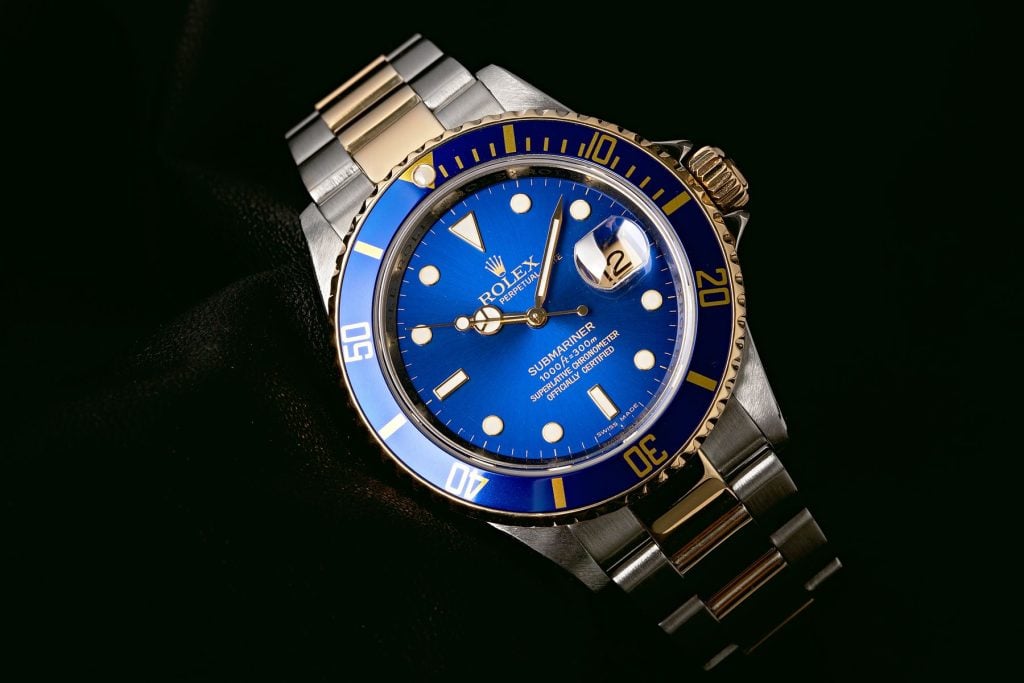
The Rolex 16613 stands as a testament to the brand’s commitment to innovation and luxury. Born from the legendary Rolex Submariner collection, this model marked a significant milestone in Rolex’s history. Introduced in 1988, the 16613 brought a touch of opulence to the rugged dive watch world with its two-tone design.
Throughout its production run from 1988 to 2010, the Rolex Submariner 16613 saw subtle refinements that enhanced its appeal. Early models featured tritium dials, later replaced by Super-LumiNova for improved luminescence. The clasp design evolved, offering better security and comfort for divers and enthusiasts alike.
Compared to modern Submariners, the 16613 retains a vintage charm with its aluminum bezel insert and slightly thinner case profile. While newer models boast ceramic bezels and broader lugs, many collectors prefer the 16613’s classic proportions and the warmth of its two-tone design, making it a bridge between vintage and contemporary Rolex aesthetics.
Key Features of the Rolex 16613
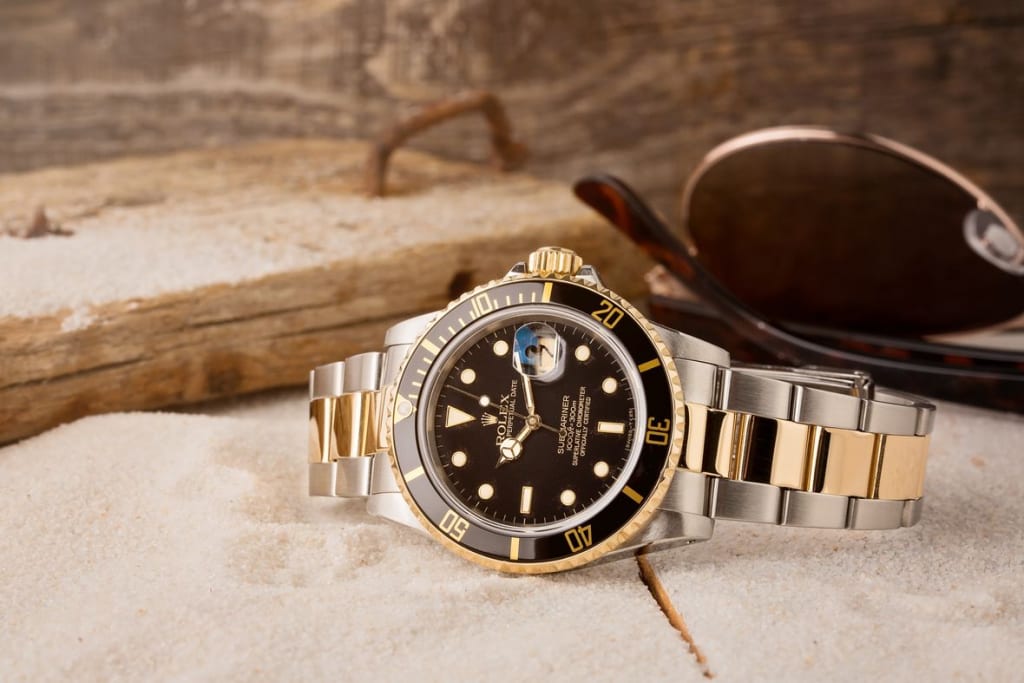
The Rolex Submariner 16613 is a masterpiece of horological engineering, combining form and function in a package that has stood the test of time. From its robust construction to its precise movement, every aspect of this watch exemplifies Rolex’s commitment to excellence. Let’s explore the key features that make the 16613 a standout model in the Submariner line.
Materials and Build Quality
The Rolex 16613 showcases a harmonious blend of durability and luxury. Its case and bracelet feature a two-tone design, marrying the strength of 904L stainless steel with the opulence of 18k yellow gold. This combination not only provides superior corrosion resistance but also offers a visual appeal that transitions seamlessly from diving excursions to formal events.
The iconic blue or black dial options complement the two-tone design, with the blue variant being particularly sought after. The dial’s color depth and sunburst finish create a mesmerizing play of light, enhancing the watch’s overall elegance. Gold-trimmed hour markers and hands provide excellent contrast, ensuring readability in various lighting conditions.
Case and Size
The Rolex Submariner 16613 boasts a classic 40mm case diameter, striking the perfect balance between presence and wearability. This size has become iconic in the watch world, suitable for a wide range of wrist sizes and preferences. The Oyster case construction, a hallmark of Rolex innovation, ensures water resistance up to an impressive 300 meters (1,000 feet).
The case profile of the 16613 is slightly slimmer compared to modern Submariner models, giving it a more subtle presence on the wrist. This design feature, coupled with the comfortable Oyster bracelet, makes the 16613 an excellent choice for daily wear. The screw-down crown, featuring Rolex’s Triplock system, further enhances the watch’s water resistance and protects the movement.
Bezel and Dial
The unidirectional rotatable bezel of the Rolex 16613 is both a functional diving tool and a design element. Featuring 60-minute graduations, it allows divers to accurately monitor their underwater time. The aluminum bezel insert, available in blue or black to match the dial, offers a classic look that has aged beautifully on many vintage pieces.
Luminescent markers on both the dial and bezel provide exceptional readability in low-light conditions, a crucial feature for professional divers. The Submariner’s signature Mercedes hands and dot markers are instantly recognizable, maintaining legibility even in the murky depths of the ocean. The date window at 3 o’clock, magnified by the Cyclops lens, adds practical functionality to the watch’s elegant design.
Movement
At the heart of the Rolex Submariner 16613 beats the reliable Caliber 3135 movement. This self-winding mechanical movement is a testament to Rolex’s watchmaking prowess, offering precision and durability that have made it a mainstay in many Rolex models. COSC-certified as a chronometer, the 3135 ensures exceptional timekeeping accuracy.
The Caliber 3135 boasts a power reserve of approximately 48 hours, allowing the watch to maintain accurate time even when left unworn over a weekend. Rolex’s Parachrom Bleu hairspring provides increased resistance to shocks and temperature variations, enhancing the movement’s overall reliability. The smooth sweeping seconds hand, moving at 28,800 vibrations per hour, is a hallmark of high-end mechanical watchmaking.
Bracelet
The Oyster bracelet of the Rolex 16613 is a perfect complement to its two-tone case. Combining brushed stainless steel outer links with polished 18k yellow gold center links, the bracelet offers both durability and luxury. The contrast between the metals creates a visual interest that elevates the watch’s overall aesthetic.
Rolex’s attention to detail extends to the bracelet’s clasp. The Glidelock extension system allows for fine adjustments without tools, ensuring a perfect fit over a wetsuit or for daily comfort. The folding Oysterlock safety clasp provides security, preventing accidental openings. These features, combined with the bracelet’s solid construction, contribute to the 16613’s reputation as a reliable companion for both underwater adventures and everyday wear.
Why the Rolex Submariner 16613 is Iconic
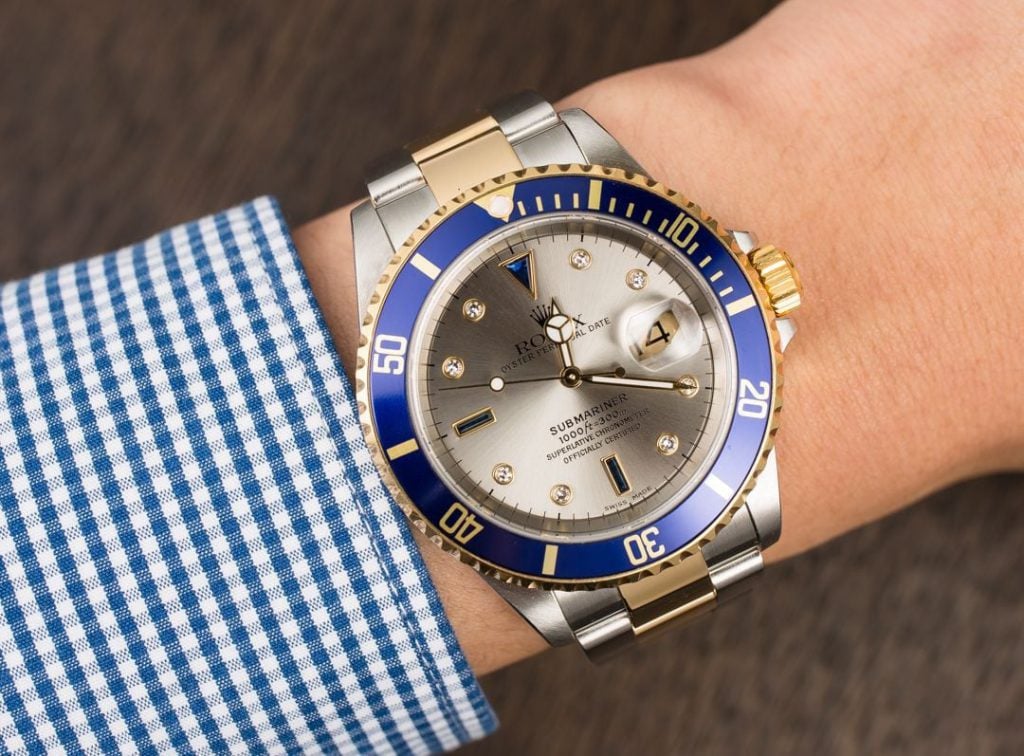
The Rolex Submariner 16613 holds a special place in the hearts of watch enthusiasts and collectors alike. Its two-tone design represents a perfect balance between sportiness and elegance, embodying the versatility that Rolex is known for. This model bridges the gap between tool watch functionality and luxurious appeal, making it a standout piece in the Submariner lineup.
Throughout its production run, the 16613 has graced the wrists of notable figures, from Hollywood celebrities to business tycoons. Its appearances in films and high-profile events have cemented its status as a symbol of success and refined taste. The watch’s ability to look equally at home in the boardroom and on the beach underscores its iconic versatility, appealing to those who appreciate a timepiece that can keep up with diverse lifestyles.
Unmatched Performance and Durability
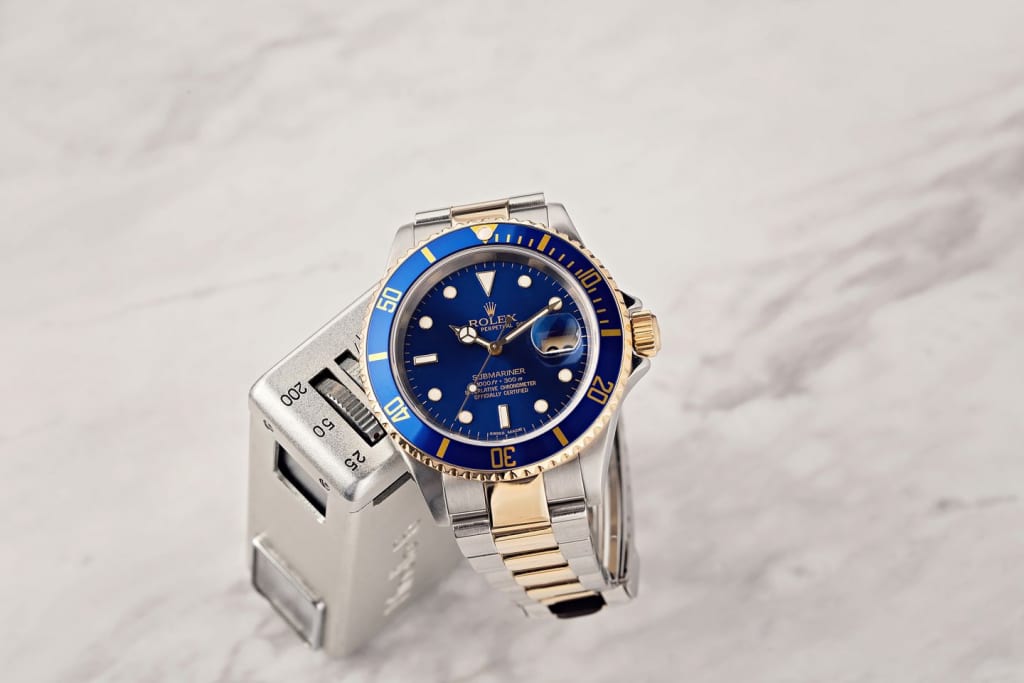
The Rolex Submariner 16613 isn’t just a pretty face; it’s a robust tool watch designed to withstand the rigors of professional diving. Its water resistance to 300 meters ensures reliable performance in underwater environments, while the unidirectional bezel provides a crucial safety feature for divers monitoring their dive times. The Triplock crown system and solid case construction contribute to its exceptional water resistance and overall durability.
The combination of stainless steel and 18k yellow gold in the 16613 offers more than aesthetic appeal. This pairing enhances the watch’s corrosion resistance, particularly important in marine environments where exposure to saltwater is common. The 904L stainless steel used by Rolex is especially resistant to pitting and maintains its luster even after years of use in harsh conditions.
Over time, the Caliber 3135 movement has proven its reliability and longevity. Many 16613 models from the late 1980s and early 1990s continue to keep excellent time with proper maintenance. The movement’s robust construction and Rolex’s use of high-quality materials contribute to its ability to withstand the test of time, often requiring only routine servicing to maintain peak performance.
A Solid Investment: The Rolex 16613’s Financial Appeal
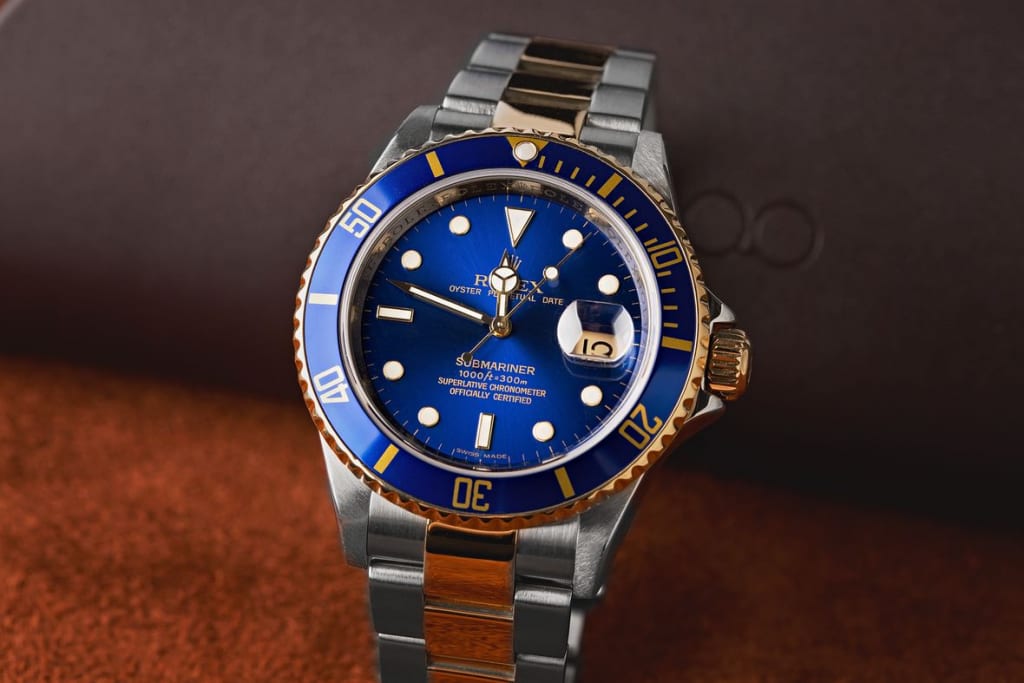
The Rolex 16613 has demonstrated impressive appreciation over the years, solidifying its status as a sound investment piece. Since its discontinuation in 2010, the model has seen steady growth in value, particularly for well-preserved examples. This appreciation reflects both the watch’s enduring popularity and the overall strength of the vintage Rolex market.
Several factors influence the investment value of a 16613. Condition is paramount, with collectors placing a premium on pieces that retain their original finish and show minimal signs of polishing. The presence of original papers and box (known as “full set”) significantly enhances value, often commanding prices 20-30% higher than watches sold without these accessories. Original parts, particularly the bezel insert and dial, are crucial for maintaining maximum value.
Compared to other Submariner models, the 16613 occupies a unique position in terms of investment potential. While it may not appreciate as rapidly as some rare vintage models, it often outperforms many modern Submariners in terms of value retention. Its two-tone design and discontinued status contribute to its desirability, positioning it as a sweet spot for collectors seeking a balance between wearability and investment potential.
Captivating Variations and Rare Finds
The Rolex Submariner 16613 offers collectors a range of variations to pursue, with dial color being a primary differentiator. The blue dial variant, often referred to as the “Bluesy,” is particularly coveted for its vibrant hue that seems to change under different lighting conditions. The black dial version, while less common, appeals to those seeking a more understated look. Both colors have their devotees, with preferences often driving slight differences in market value.
Within the 16613 line, certain variations have become highly sought after by collectors. Early models featuring tritium dials, identified by the “T SWISS T” or “SWISS T<25” markings at the bottom of the dial, command a premium. Dials with specific color variations or subtle production changes, such as the “flat four” bezel (where the ‘4’ in ’40’ on the bezel has a flat top), can significantly increase a watch’s collectibility and value.
The presence of original box and papers cannot be overstated when it comes to the 16613’s collectibility and resale value. A full set not only provides provenance but also offers insight into the watch’s history and authenticity. Collectors are often willing to pay a substantial premium for a complete set, sometimes up to 25-30% more than for the watch alone. This emphasis on documentation underscores the importance of preserving all original materials when purchasing a luxury timepiece.
Your Buying Guide to the Perfect Rolex 16613
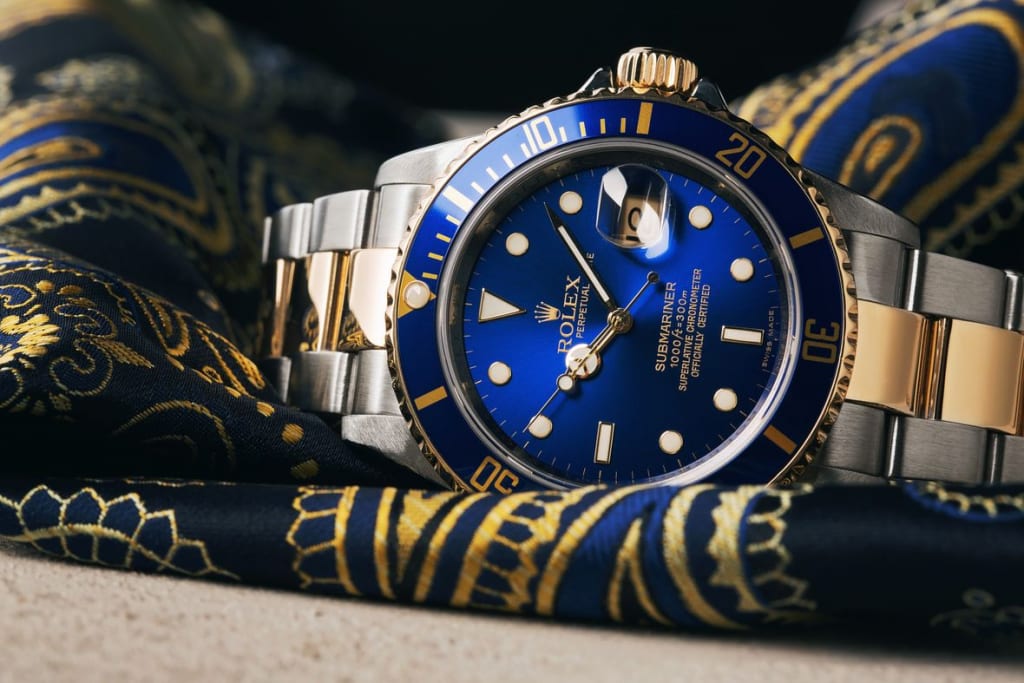
When venturing into the world of pre-owned Rolex Submariner 16613s, knowledge is your greatest asset. Start by familiarizing yourself with the model’s hallmarks: the two-tone design, the specific shade of blue or black on the dial and bezel, and the characteristic Oyster bracelet. Pay close attention to the overall condition, looking for signs of excessive wear or poor maintenance that might indicate a troubled history.
Authenticity is paramount when purchasing a Rolex 16613. Familiarize yourself with the model’s specific features, such as the engraved rehaut (the space between the dial and crystal), the precise positioning of dial text, and the quality of the cyclops magnification. The serial and model numbers should be correctly positioned between the lugs. When possible, ask for detailed, high-resolution images of these areas to scrutinize before making a purchase.
Be wary of Submariner 16613s with aftermarket modifications. While some changes, like a strap swap, are easily reversible, others can significantly impact the watch’s value and authenticity. Aftermarket dials, non-original hands, or replaced bezels are red flags that should prompt caution. If considering a modified piece, ensure that all original parts are included with the sale to maintain the watch’s long-term value.
The importance of purchasing from a trusted dealer cannot be overstated. Reputable sellers offer authenticity guarantees, detailed service histories, and often provide warranties on pre-owned pieces. They should be willing to answer all your questions and provide detailed information about the watch’s condition and history. While you might pay a slight premium compared to private sales, the peace of mind and after-sale support are invaluable when investing in a luxury timepiece like the Rolex Submariner 16613.
Conclusion: Why the Rolex 16613 Remains a Sought-After Model
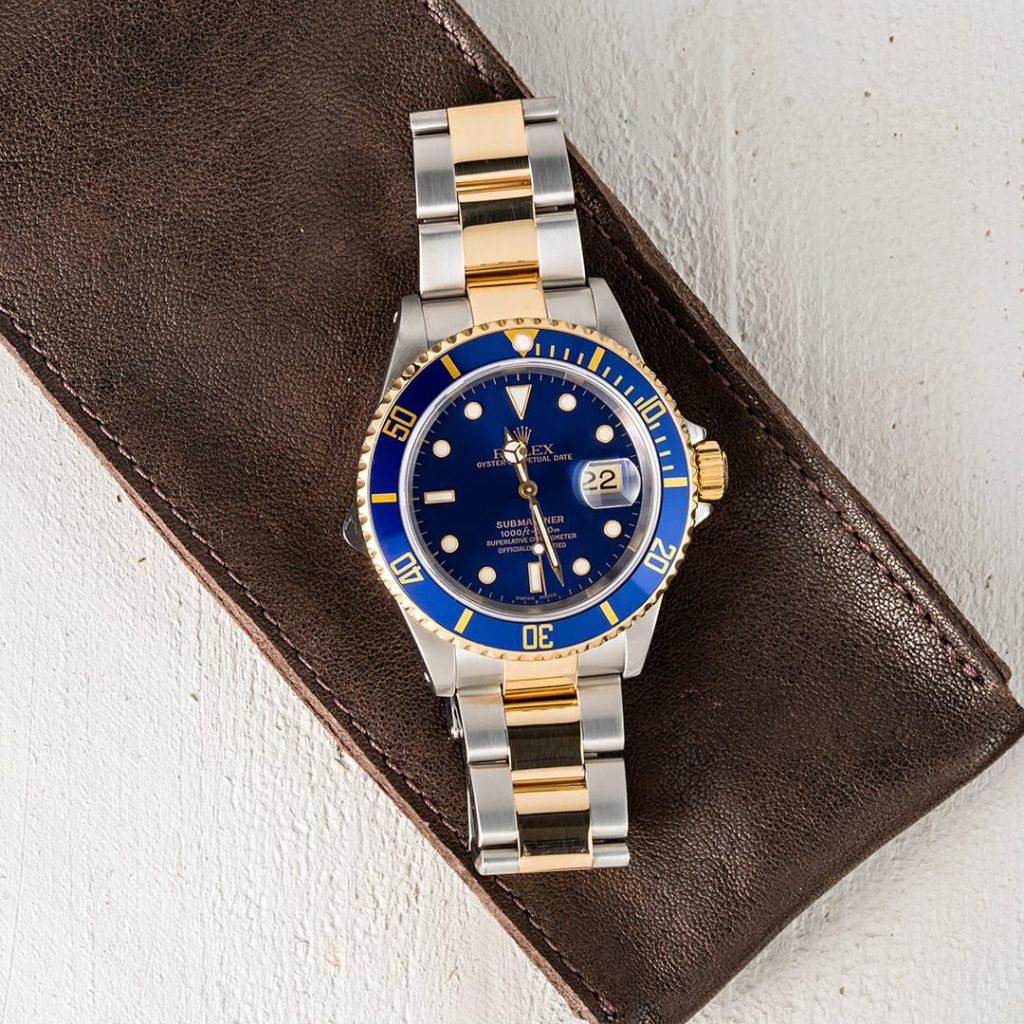
The Rolex 16613 stands as a testament to timeless design and uncompromising quality. Its blend of functionality and luxury has captivated watch enthusiasts for decades, cementing its place in horological history. From its robust performance as a dive watch to its elegant presence in social settings, the 16613 exemplifies versatility in luxury watchmaking.
For those considering adding a Rolex Submariner 16613 to their collection, it represents more than just a timepiece. It’s an investment in craftsmanship, a piece of watchmaking history, and a symbol of personal achievement. Whether you’re drawn to its technical prowess, its investment potential, or simply its classic good looks, the 16613 offers something special for every watch lover.
If you’re in the market for a Rolex 16613 for sale, look no further than Bob’s Watches. As specialists in luxury timepieces, we offer a curated selection of authenticated Rolex Submariner models, including the iconic 16613. Our team of experts is ready to guide you through the selection process, ensuring you find the perfect example to cherish for years to come.
With over two decades of experience in the luxury watch industry, the Bob's Watches Editorial Team stands at the forefront of watch expertise and insight. Our team, composed of seasoned watch enthusiasts, skilled horologists, and knowledgeable industry insiders, is dedicated to bringing you the latest and most accurate information in the world of luxury timepieces. We pride ourselves on our meticulous attention to detail and our unwavering commitment to authenticity. Our editorial content is a reflection of our passion for luxury watches and our dedication to providing our readers with comprehensive, unbiased, and up-to-date information. Our expertise spans a wide range of topics, including in-depth reviews of the latest models, historical retrospectives of iconic timepieces, and insightful analyses of market trends. We are also renowned for our detailed guides on watch maintenance and investment advice, making us a trusted resource for both seasoned collectors and new enthusiasts alike. As thought leaders in the watch industry, we understand the importance of staying ahead of the curve. That's why we continually update our knowledge and skills, ensuring that our readers receive the most current and relevant information. Whether you're seeking advice on your next luxury watch purchase or looking to deepen your understanding of watch craftsmanship, the Bob's Watches Editorial Team is here to guide you.